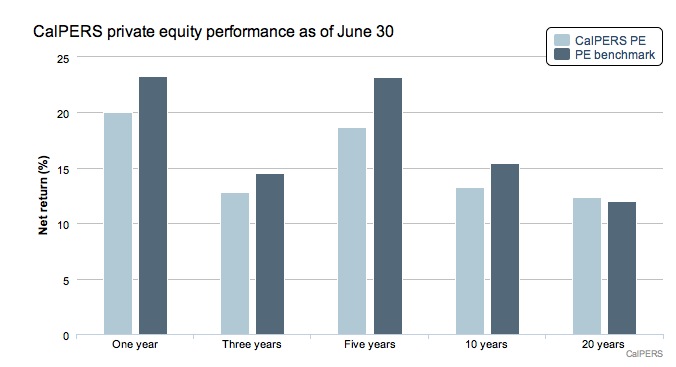It was revealed last week that CalPERS has plans to review its private equity benchmarks. The pension giant’s staff says the benchmark is too aggressive – in their words, the current system “creates unintended active risk for the program”.
Pension360 last week published the take of Naked Capitalism’s Yves Smith on the situation. Here’s the analysis of pension investment analyst Leo Kolivakis, publisher of Pension Pulse, who takes a different stance.
____________________________________
By Leo Kolivakis [Originally published on Pension Pulse]
I was contacted in January 2013 by Réal Desrochers, their head of private equity who I know well, to discuss this issue. Réal wanted to hire me as an external consultant to review their benchmark relative to their peer group and industry best practices.
Unfortunately, I am not a registered investment advisor with the SEC which made it impossible for CalPERS to hire me. I did however provide my thoughts to Réal along with some perspectives on PE benchmarks and told him unequivocally that CalPERS current benchmark is very high, especially relative to its peers, making it almost impossible to beat without taking serious risks.
Almost two years later, we now find out that CalPERS is looking to change its private equity benchmark to better reflect the risks of the underlying portfolio. Yves Smith of Naked Capitalism, aka Susan Webber, came out swinging (again!) stating CalPERS is lowering its private equity benchmark to justify its crappy performance.
There are things I agree with but her lengthy and often vitriolic ramblings just annoy the hell out of me. She didn’t bother to mention how Réal Desrochers inherited a mess in private equity and still has to revamp that portfolio.
More importantly, she never invested a dime in private equity and quite frankly is far from being an authority on PE benchmarks. Moreover, she is completely biased against CalPERS and allows this to cloud her objectivity. Also, her dispersion argument is flimsy at best.
Let me be fully transparent and state that neither Réal Desrochers nor CalPERS ever paid me a dime for my blog even though I asked them to contribute. I am actually quite disappointed with Réal who seems to only contact me when it suits his needs but I am still able to maintain my objectivity.
I remember having a conversation with Leo de Bever, CEO at AIMCo, on this topic a while ago. We discussed the opportunity cost of investing in private markets is investing in public markets. So the correct benchmark should reflect this, along with a premium for illiquidity risk and leverage. Leo even told me “while you will underperform over any given year, you should outperform over the long-run.”
I agreed with his views and yet AIMCo uses a simple benchmark of MSCI All Country World Net Total Return Index as their private equity benchmark (page 33 of AIMCo’s Annual Report). When I confronted Leo about this, he shrugged it off saying “over the long-run it works out fine.” Grant Marsden, AIMCo’s former head of risk who is now head of risk at ADIA, had other thoughts but it shows you that even smart people don’t always get private market benchmarks right.
And AIMCo is one of the better ones. At least they publish all their private market benchmarks and I can tell you the benchmarks they use for their inflation-sensitive investments are better than what most of their peers use.
Now, my biggest beef with CalPERS changing their private equity benchmark is timing. If we are about to head into a period of low returns for public equities, then you should have some premium over public market investments. The exact level of that premium is left open for debate and I don’t rely on academic studies for setting it. But there needs to be some illiquidity premium attached to private equity, real estate and other private market investments.
Finally, I note the Caisse’s private equity also underperformed its benchmark in 2013 but handily outperformed it over the last four years. In its 2013 Annual Report, the Caisse states the private equity portfolio underperformed last year because “50% of its benchmark is based on an equity index that recorded strong gains in 2013″ (page 39) but it fails to provide what exactly this benchmark is on page 42.
Also, in my comment going over PSP’s FY 2014 results, I noted the following:
Over last four fiscal years, the bulk of the value added that PSP generated over its (benchmark) Policy Portfolio has come from two asset classes: private equity and real estate. The former gained 16.9% vs 13.7% benchmark return while the latter gained 12.6% vs 5.9% benchmark over the last four fiscal years. That last point is critically important because it explains the excess return over the Policy Portfolio from active management on page 16 during the last ten and four fiscal years (click on image).
But you might ask what are the benchmarks for these Private Market asset classes? The answer is provided on page 18 (click on image).
What troubles me is that it has been over six years since I wrote my comment on alternative investments and bogus benchmarks, exposing their ridiculously low benchmark for real estate (CPI + 500 basis points). André Collin, PSP’s former head of real estate, implemented this silly benchmark, took all sorts of risk in opportunistic real estate, made millions in compensation and then joined Lone Star, a private real estate fund that he invested billions with while at the Caisse and PSP and is now the president of that fund.
And yet the Auditor General of Canada turned a blind eye to all this shady activity and worse still, PSP’s board of directors has failed to fix the benchmarks in all Private Market asset classes to reflect the real risks of their underlying portfolio.
All this to say that private equity, real estate, infrastructure and timberland benchmarks are all over the map at the biggest best known pension funds across the world. There are specific reasons for this but it’s incredibly annoying and frustrating for supervisors and stakeholders trying to make sense of which is the appropriate benchmark to use for private market investments, one that truly reflects the risks of the underlying investments (you will get all sorts of “expert opinions” on this subject).
Photo by rocor via Flickr CC License


